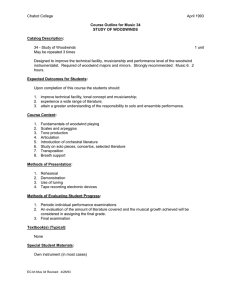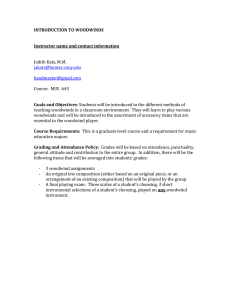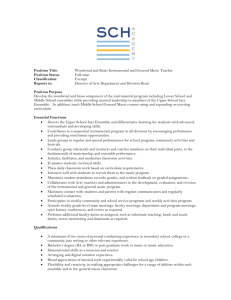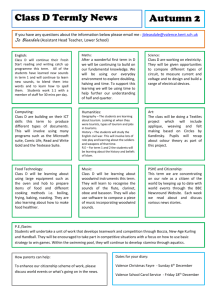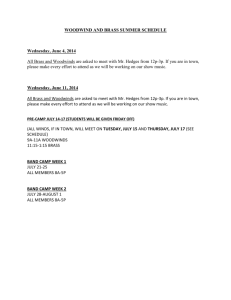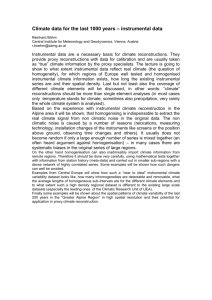MUSIC CURRICULUM COURSE REVIEW
advertisement
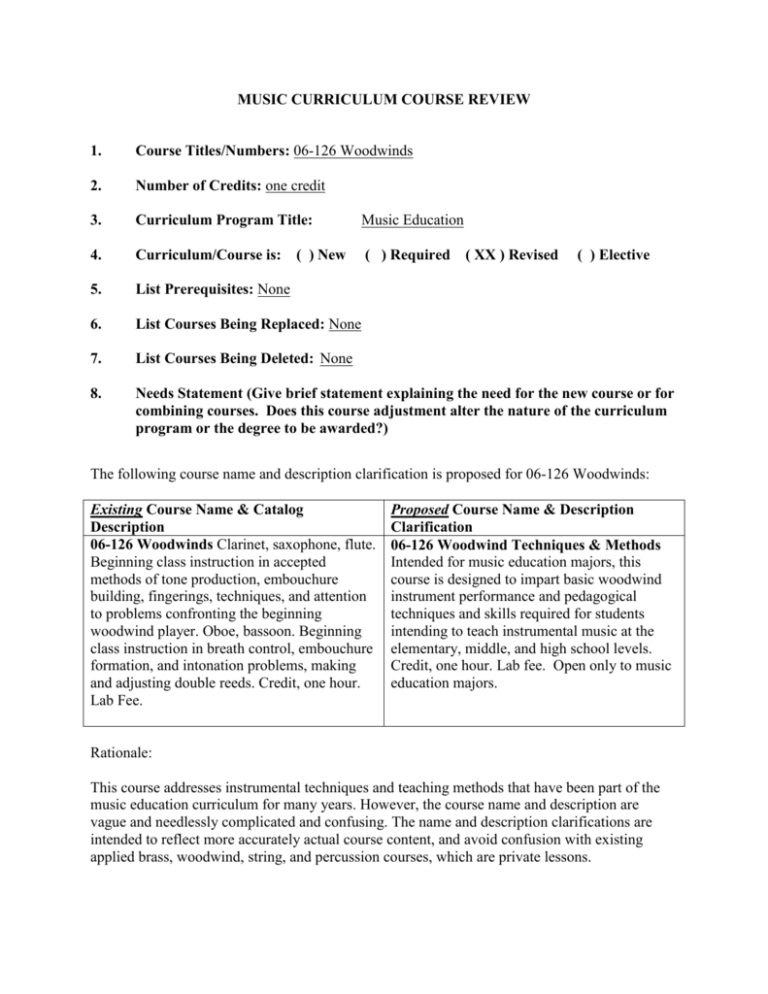
MUSIC CURRICULUM COURSE REVIEW 1. Course Titles/Numbers: 06-126 Woodwinds 2. Number of Credits: one credit 3. Curriculum Program Title: Music Education 4. Curriculum/Course is: ( ) Required 5. List Prerequisites: None 6. List Courses Being Replaced: None 7. List Courses Being Deleted: None 8. Needs Statement (Give brief statement explaining the need for the new course or for combining courses. Does this course adjustment alter the nature of the curriculum program or the degree to be awarded?) ( ) New ( XX ) Revised ( ) Elective The following course name and description clarification is proposed for 06-126 Woodwinds: Existing Course Name & Catalog Description 06-126 Woodwinds Clarinet, saxophone, flute. Beginning class instruction in accepted methods of tone production, embouchure building, fingerings, techniques, and attention to problems confronting the beginning woodwind player. Oboe, bassoon. Beginning class instruction in breath control, embouchure formation, and intonation problems, making and adjusting double reeds. Credit, one hour. Lab Fee. Proposed Course Name & Description Clarification 06-126 Woodwind Techniques & Methods Intended for music education majors, this course is designed to impart basic woodwind instrument performance and pedagogical techniques and skills required for students intending to teach instrumental music at the elementary, middle, and high school levels. Credit, one hour. Lab fee. Open only to music education majors. Rationale: This course addresses instrumental techniques and teaching methods that have been part of the music education curriculum for many years. However, the course name and description are vague and needlessly complicated and confusing. The name and description clarifications are intended to reflect more accurately actual course content, and avoid confusion with existing applied brass, woodwind, string, and percussion courses, which are private lessons. 9. Catalogue Description of the Course: See old and new course names/descriptions above. 10. List Objectives of the Course: Students will learn basic performance techniques on the instruments indicated in the course title, improving their problem-solving skills and competency as professional music educators. Students will learn pedagogical techniques on the instruments identified in the course title, improving their problem-solving skills and competency as professional music educators. Students will learn how to apply these techniques in elementary, middle, and high school instrumental teaching environments, improving their problem-solving skills and competency as professional music educators. 11. Course Outline (Attach Typical Course Outline) See attached sample syllabus. 12. Show how the proposed course fits into the curriculum or course sequence. Attach course descriptions and list course numbers. This revised course name and description does not change the existing curriculum or course sequencing in any way. 13. Are there comparable courses in other departments? If so, list all comparable courses here. (Attach course descriptions for all comparable courses.) No 14. How will students be affected by this course change? Will this course improve students’ professional competence, employability, and ability to pass professional examinations? Does this course increase the number of credit hours required for graduation? Do the course prerequisites increase the total number of semester hours in this curriculum program? Students will not be impacted by this course name and description revision in any way, but registration confusion with existing applied instrumental courses will be eliminated. This revision also does not change total credit hours in the curriculum, or credit hours required for graduation. 15. What effect will this new course have on University resources? require new or additional resources and/or staffing? None Will this course 16. How will this new course benefit the University? This is not a new course. 17. How will the change affect the program? The name and description revision for this course more accurately reflect its content and purpose, thus eliminating existing confusion for students, advisers, and outside accrediting agencies, especially with other similarly named applied music courses. Submitted by:____Dr. John Graulty_________ Date: __3/14/2008____ Approved by the Faculty of Department (Date) _______3/13/2008_____________ The curriculum committees of the Music Department and the College of Arts, Humanities, and Social Sciences have endorsed these clarifications, as has the Council for Professional Education (CPE). SAMPLE SYLLABUS DELAWARE STATE UNIVERSITY MUSIC DEPARTMENT I. COURSE TERM: COURSE TITLE: COURSE NUMBER: COURSE SCHEDULE: COURSE LOCATION: INSTRUCTOR: E-MAIL ADDRESS: OFFICE: OFFICE HOURS: REQUIRED TEXT: II. COURSE DESCRIPTION 2008 Fall Semester Woodwind Techniques & Methods 06-126-00 TR 1:30-2:20 p.m. EH 149 Dr. LaPointe M. Davis ladavis@desu.edu; lapointedavis@comcast.net EH Building 297 As indicated on office door Westphal, F.W. (1990) A guide to teaching woodwinds (5th ed.), Wm. C. Brown: Iowa Intended for music education majors, this course is designed to impart basic woodwind instrument performance and pedagogical techniques and skills required for students intending to teach instrumental music at the elementary, middle, and high school levels. Students are engaged in identifying basic performance problems and their solutions. Additionally, peer teaching experiences are provided so that students can have opportunities to develop knowledge and skill in teaching woodwind instruments to their classmates. Credit, one hour. Lab fee. Open only to music education majors. III. RATIONALE/JUSTIFICATION This course is important to the development of music education majors as they prepare to teach prepare to instrumental music in the public and private schools. Instrumental music teachers are expected to model instruction on beginning woodwind instruments and should have adequate teaching knowledge of these instruments. During the progression of this class, students are to develop their critical thinking and listening skills for their continued improvement and self- evaluation. At various times, students will function as decision makers, planners, evaluators, and reflective thinkers during instrumental performance and instruction. IV. COURSE PERFORMANCE OBJECTIVE/OUTCOMES Conceptual Framework Components (PEU) D=Diversity I=Interpersonal Communications R=Reflection E=Effective Teaching and Assessment Strategies C=Content T=Technology Delaware Teaching Standards (DTS) 1 Content 2 Human Development & Learning 3 Diverse Learners 4 Communication 5 Learning Environment 6 Planning 7 Instructional Strategies 8 Assessment 9 Professional Growth 10 Professional Relationships 11 Educational technology 12 Professional Conduct *National Association of State Directors of Teacher Education Certification Standard *NASDTEC General Standards For Music (3.5.23) I The program shall require demonstrated competence in the knowledge of the common elements of music-rhythm, melody, harmony, timbre, texture, dynamics, form, and their interaction-and the ability to analyze music both aurally and visually in relation to these elements. II The program shall require demonstrated competence in conducting, score reading, and rehearsal techniques. III The program shall require demonstrated competence at an advanced level in one applied musical area to assure accurate and musically expressive performances. IV The program shall require demonstrated competence in a variety of large and small ensembles. V The program shall require demonstrated competence in the knowledge of music history and literature and the relationship of music to the other arts with emphasis on historical and stylistic perspectives. VI The program shall require demonstrated competence in evaluating musical works and performances. The Objectives of this Course are to: 1. develop students’ woodwind performance skills (DIRECT – DTS – 1-8, NASDTEC III, IV) 2. develop student’s knowledge and understanding of the fundamentals of woodwind performance – tone production, articulation, playing position, etc. (DIRECT, NASDTEC, III & VI) 3. develop students’ woodwind teaching skills. (DIRECT - DTS 1-8, 12, NASDTEC, II, III, VI) 4. develop students’ knowledge of appropriate woodwind method books for beginning and intermediate students (DIRECT – DTS 1-9, NASDTEC VI) 5. develop students’ knowledge of basic woodwind instrument transposition (DIRECT – DTS 1, 6, 8, DTS III) V. TOPICAL OUTLINE Week I: Week II-V: Week VI-IX: Weeks X-XII: Weeks XIII-XV: VI. The Purpose and Importance of the Course A Philosophy of Instrumental Music Education The Flute Tone Production Playing Position Hand and Finger Positions Articulation Performance Experiences Peer Teaching Common Problems and Solutions The Clarinet Tone Production Playing Position Hand and Finger Positions Articulation Performance Experiences Peer Teaching Common Problems and Solutions The Alto Saxophone Tone Production Playing Position Hand and Finger Positions Articulation Performance Experiences Peer Teaching Common Problems and Solutions The Oboe and Bassoon Tone Production Playing Position Hand and Finger Positions Articulation Performance Experiences Peer Teaching Common Problems and Solutions INSTRUCTIONAL METHODS/BEST PRACTICES A. B. C. D. E. Lecture Teacher-Guided Discovery Cooperative Learning (group work) Teacher-Modeling VII. LEARNING ACTIVITIES/PROJECTS A. B. C. D. Class Lectures Students’ In-Class Performances Course Evaluations: Practical and Written Tests, Final Examination Peer Teaching Experience VIII. EVALUATION Grading Scale: The scale indicated below will be used to compute grades for all assignments, tests, examinations and the final grade. 93-100=A 85-92=B 77-84=C 70-76=D Below 70=F Final grades will be calculated in the following manner: 1. Written assignments, written tests, 60% of the average of scores performance tests, and peer teaching evaluations 2. On Time Class Attendance 20% of the total number of classes attended on time 3. Final Examination 20% of the score POLICIES AND PROCEDURES Course Requirements All students are required to: A. Attend punctually all class meetings. This class will start promptly at the scheduled hour. The University’s attendance policy indicated below will be strictly enforced: No student may attend class unless officially registered. 1. All students are expected to attend punctually every scheduled class meeting except in the case of serious illness or some other emergency. Students who arrive after the roll is taken will be marked absent. 2. Absence from class for any reason does not excuse the student from his/her responsibility for completing all assigned work and/or tests. B. Purchase a text for the course. C. Submit and/or complete all assignments on the dates designated. Late assignments will not be accepted except in the case of an excused absence. D. Take examinations on the date scheduled except in the case of illness or emergency. Students who do not have an excused absence and are not present on the designated day of the test or examination will receive a grade of “F”. E. It is the student’s responsibility to inform the instructor in advance (or as soon as reasonably possible) of any emergency or circumstance preventing the aforementioned to occur. No consideration will be given to make-up work if the student’s responsibility has not been fulfilled. GLOBAL PERSPECTIVE The examination of the major musical style periods, composers and their compositions brings a global perspective to the course as many diverse cultures are explored. BIBLIOGRAPHY/REFERENCES Pearson, B. (1993) Standard of excellence band method. Neil A. Kjos: California
